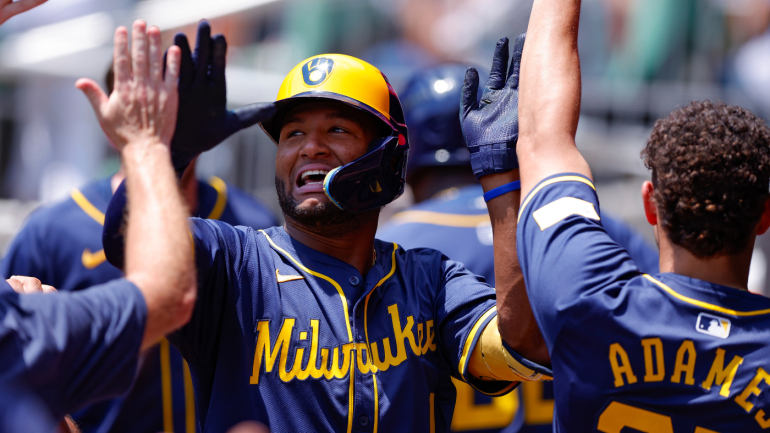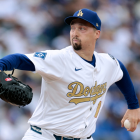
An eternal truth about baseball is that it will keep you humble. For evidence of that, consider the Milwaukee Brewers. Coming into the year, it seemed reasonable to think they would take a step back from last season's division crown. After all, the Brewers' winter had been defined by loss: of manager Craig Counsell, of top executive David Stearns, and of ace Corbin Burnes. Milwaukee added some talent, too -- Rhys Hoskins and Gary Sánchez included -- but on paper it didn't seem like enough to offset the subtractions.
That's why it qualifies as a surprise that we're here in late August, and the Brewers have more than a lead in the National League Central -- they entered the week with the largest division lead in all of Major League Baseball.
The recent news of Christian Yelich's season-ending back surgery aside, this has been an impressive year from the Brewers. So, just how have they pulled it off? Let's tackle three developments that help to explain their surprising success.
1. Internal development
You can identify a few younger Brewers hitters as key pieces of their success -- William Contreras, Joey Ortiz, Blake Perkins, and more recently Garrett Mitchell included. We mean no disrespect to any of them when we write that we have two players in particular in mind for this subhead: second baseman Brice Turang and outfielder Jackson Chourio.
Turang, 24, is one of the best defensive second basemen in the game as well as a prolific thief who has swiped 37 bases on 42 attempts. That helps to explain why he's been Milwaukee's most productive player this season (as judged by Baseball Reference's Wins Above Replacement metric) despite a below-average offensive line.
To be fair, Turang has made some gains at the plate, too. He's shown improved bat-to-ball skills (he's whiffed on about 13% of his swings), and he's shifted his batted-ball profile to include more grounders and line drives -- the kind of contact that allows him to better leverage his well-above-average wheels. Is Turang ever going to be more than a bottom-third hitter? Possibly not. But the secondary skills appear strong enough to keep him where he is, a productive member of a good ballclub.
Jackson Chourio zooms around the bags in 11.12 seconds for his first MLB triple 🏃♂️
— MLB Pipeline (@MLBPipeline) August 17, 2024
The rookie outfielder records the fastest home-to-third time of any member of the @Brewers this year! pic.twitter.com/jl5udWTUGr
Chourio, 20, looks like a star on the rise. The Brewers gambled on that outcome, handing him $82 million guaranteed before he had taken a big-league cut. Chourio started his season slow, leading to questions about whether or not he needed a return trip to the minors to work on his approach. The Brewers stayed the course, and he's since rewarded them by flirting with a .900 OPS since the start of June.
Over the course of the season, Chourio has made several tweaks to his game. He's reduced his swing rate since the first two months of the year, and he's improved his ability to make consistent, quality contact -- in terms of both impact and trajectory. In other words, everything seems to be trending in the right direction.
Chourio is all but certain to notch a 20-20 season thanks to his high-grade wheels and the kind of power that plays to both alleyways. Given his youth, we think it's reasonable to expect him to have some 30-30 campaigns in his future -- and, who knows, maybe he'll even record the franchise's first 40-40 effort in due time.
2. Unexpected contributors
It's one thing to help young players grow into positive contributors as anticipated. It's another to do the same with random guys, the way the Brewers have made a habit of doing.
When we analyzed the Corbin Burnes trade in the spring, we wrote of DL Hall's chances to make an outsized impact that "the Brewers have excelled in getting the most from their pitchers in recent years -- some of our sources have talked up Cameron Castro, Milwaukee's vice president of player development, as a key on that end." Hall hasn't been a huge factor in Milwaukee's season (he's made five appearances around injuries and demotion), but the Brewers have flexed those muscles elsewhere.
Coming into today, four of the Brewers' top 12 productive players this season (as judged by Baseball Reference's Wins Above Replacement metric) were pitchers who could charitably be described as journeyman types. Let's touch on each of them.
- LHP Bryan Hudson: The Brewers obtained Hudson from the Dodgers in a small January trade. (He had previously joined the Dodgers in late 2022 as a minor-league free agent.) He's since compiled a 1.65 ERA over 38 appearances, all the while showing he can throw multiple innings and work leverage spots.
- RHP Tobias Myers: The Brewers signed Myers as a minor-league free agent in November 2022. He was already well-traveled by that point, having spent time with four other organizations. It doesn't look like he'll be adding to his collection anytime soon, having amassed a 2.81 ERA in 19 games (18 of them starts).
- RHP Colin Rea: We had Rea slotted into our top-50 free agent list last winter, but the Brewers acted quickly to retain him on a one-year deal with a club option. Rea, who had previously pitched for three other organizations, would seem likely to remain with the Brewers into next season given his 119 ERA+ and 3.00 strikeout-to-walk ratio this year over his first 23 appearances.
- LHP Jared Koenig: Koenig appeared in 10 games with the 2022 Athletics before the Brewers inked him. He's made a bigger impact this season than could have been reasonably expected from a 30-year-old with limited big-league experience, tallying a 2.09 ERA across 47 1/3 innings.
If you want to know how a team could trade Burnes and lose Brandon Woodruff and Devin Williams to injury for all/much of the season without its staff missing a beat … well, this is how. The Brewers have the best ERA among NL teams (despite a lack of starpower) because they know how to identify pitchers with the traits they like, and then how to work with those pitchers to maximize their output. It's not the approach that grabs headlines, but clearly it's effective in the ways that matter.
3. Central dominance
The easiest way to build a large division lead is to win a lot of games. The second easiest way is to win a lot of games against your divisional foes, racking up pivotal head-to-head victories in the process.
The Brewers have checked off both boxes: they enter Tuesday with a 72-52 record on the season, and they've certainly delivered whenever they've faced a NL Central foe.
To wit, the Brewers are 25-14 against the other four teams in their division (as compared to 47-38 against everyone else). Prorated over a full season, that winning percentage works out to 104 victories. Additionally, the Brewers have outscored their NL Central rivals by 54 runs over those games, or nearly 1.4 runs per contest.
The Brewers are 6-1 against the St. Louis Cardinals, 8-5 against the Chicago Cubs, and 6-3 against the Cincinnati Reds. The only Central team to give the Brewers any real trouble has been the Pittsburgh Pirates, who are 5-5 this year against Milwaukee.
The Brewers' dominance against their Central opponents has provided them with a nice cushion heading into the season's final weeks. That doesn't mean Milwaukee can afford to relent whenever they're playing a divisional game, however. The Brewers have 13 more games to play against Central opponents before the season wraps.
If the Brewers keep their foot on the pedal, the way they have all year, they should coast to consecutive NL Central crowns for the first time in franchise history.
![[object Object] Logo](https://sportshub.cbsistatic.com/i/2020/04/22/e9ceb731-8b3f-4c60-98fe-090ab66a2997/screen-shot-2020-04-22-at-11-04-56-am.png)



















